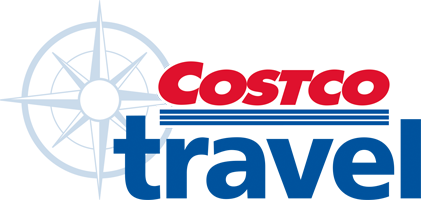
Asia Africa and Middle East: Southeast Asia & Japan's Crafts & Cherry Blossoms Voyage
Seabourn®
Embark on unforgettable new itineraries with Seabourn Encore, taking in the spring flowers of Japan, the modern marvels of Singapore, and the culinary delights of Southeast Asia. Enjoy access to at least 19 UNESCO World Heritage sites, visits to boutique ports, and complimentary special events and experiences including our Caviar in the Surf®, and Shopping with the Chef in select destinations — all while enjoying Seabourn Ultra-Luxury.
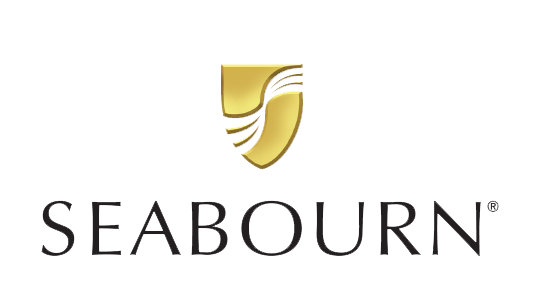
All onboard gratuities
Select complimentary shore excursions**
Unlimited beverages, including fine wines and premium spirits served throughout the ship
Complimentary dining venues
Complimentary in-suite bar
Complimentary caviar
Complimentary Wi-Fi packages with unlimited minutes
Welcome bottle of Champagne
Executive Member Benefit
Executive Members receive an annual 2% Reward, up to $1,250, on qualified Costco Travel purchases
Digital Costco Shop Card
Member Exclusive: Digital Costco Shop Card with every Seabourn® sailing†
Sailing Itinerary

Note: Cruise itineraries are subject to change. Please verify ports and times directly with the cruise line.
Overview
Though physically small, Singapore is an economic giant. It has been Southeast Asia's most modern city for over a century. The city blends Malay, Chinese, Arab, Indian, and English cultures and religions. Its unique ethnic tapestry affords visitors a wide array of sightseeing and culinary opportunities from which to choose. A full calendar of traditional festivals and holidays celebrated throughout the year adds to its cultural appeal. In addition, Singapore offers luxury hotels, delectable cuisine,e, and great shopping! Located at the tip of the Malay Peninsula, Singapore's tropical climate welcomes both leisure and business travelers year-round. The island republic's excellent infrastructure enables visitors to enjoy its many sites and attractions in a safe, clean, and green environment. Award-winning Changi Airport provides air links to major cities around the world. The train and subway systems are clean, fast,t and efficient. In addition, its state-of-the-art cruise terminal has established Singapore as one of the premier cruising centers in Southeast Asia and an exciting port of call on any Asian cruise itinerary. In the city, there is no need for a car. Public transportation is excellent and walking is a good way to explore the city. All major attractions are also accessible by tour bus. Since the city is only 60 miles (100k) from the equator, the tropical temperatures do not vary much. Rainfall is fairly evenly distributed throughout the year. No matter when you choose to visit, warm weather will be abundantly available. The visitor is struck immediately by Singapore's abundance of parks, nature reserves, and lush, tropical greenery. Singapore's progress over the past three decades has been remarkable, yet the island has not been overwhelmed by development. Visitors will discover a wealth of historical treasures from the past, in the beauty of older buildings, values, and traditions that have survived in the face of profound social and geographical change. Lacking any noteworthy natural resources, Singapore's early prosperity was based on a vigorous free trade policy, put in place in 1819 when Sir Stamford Raffles first established it as a British trading post. Later, mass industrialization bolstered the economy, and today the state boasts the world's second busiest port after Rotterdam, minimal unemployment, and a super-efficient infrastructure. Almost the entire population lives in upscale new apartments, and the average per capita income is over US$12,000. Singapore is a clean, safe place to visit, its amenities are second to none and its public places are smoke-free and hygienic. Forming the core of downtown Singapore is the Colonial District. Each surrounding enclave has its distinct flavor, from the aromatic spice stores of Little India to the tumbledown backstreets of Chinatown, where it is still possible to find calligraphers and fortune tellers, or the Arab Quarter, whose cluttered stores sell fine cloths and silks. North of the city, are two nature preserves, Bukit Timah and the Central Catchment Area, along with the splendid Singapore Zoological Gardens. The East Coast features good seafood restaurants set on long stretches of sandy beach. In addition, there are over fifty islands and islets within Singaporean waters, all of which can be reached with varying degrees of ease. Day trips are popular to Sentosa, the island amusement arcade which is linked to the south coast by a short causeway and cable car. Music, theater, and nightlife: all are abundant in this remarkable city. Singapore used to be considered a "stopover" on the way to larger Asian cities. This is no longer true! Visitors seek out Singapore for business and finance and also for a fascinating and satisfying vacation for the whole family. Strategically located at the southern tip of the Malay Peninsula sixty miles from the equator, Singapore has for centuries been a crossroads between East and West. Chinese traders en route to India had navigated its waters from at least the 5th century. In the 14th century, it was part of the powerful Vijayan Empire and was known as Temasek or Sea Town. Legend has it that it was renamed Singa Pura or Lion City after a visiting Sumatran prince saw an animal he mistook for a lion, an animal considered a good omen. Modern Singapore came into being in 1819 when Sir Stamford Raffles claimed what was then a small fishing village as a regional base for the East India Company. The island's natural harbor and location made it an ideal site for a trading post serving British trade interests between China, the Malay world, and India. Singapore flourished as its free trade policy attracted merchants and residents from all over the world. Raffles initiated a town plan which included leveling one hill to form a new commercial district (now Raffles Place) and constructing government buildings around another hill (now called Fort Canning Hill). The British plan also involved separating the population according to ethnic categories with Europeans, Indians, Chinese,e, and Malays each living and working in the distinct quarters of the city. Revenues soared in the ensuing years from the production of opium and rubber. Millionaires were made overnight. Immigration rose steadily. The island became Britain's strategic defense base in the Far East but fell to the Japanese in 1942. After the world war ended in 1945, Singapore became a crown colony. It gained self-governing status in 1959 and independence in 1965 when it became part of the new state of Malaysia which united Malaya with Singapore, Sabah, and Sarawak. The alliance did not last. Singapore was used to being on its own, and within two years the island set up its stable government and became known as the Republic of Singapore. Under Prime Minister Lee Kuan Yew's leadership, Singapore continued to strengthen its infrastructure and its industrial base. Housing and urban renovation kept pace with population growth. The areas of health and education are strong. Singapore's leaders have also brought order and progress through strict regulation of social behavior. Smoking in public was banned, as was gum chewing. High economic growth rates have supported political stability. Singapore is the world's second busiest seaport and has an airport served by over 50 major airlines. It has state-of-the-art communication and mass transit systems. It is Asia's premier center for finance and business and the world's third-largest oil refining center. Over 7 million visit the tiny island every year.
Overview
In the core of the Mekong Delta, Ho Chi Minh City, formerly known as Saigon, is second the most important in Vietnam after Hanoi. It is not only a commercial center but also a scientific, technological, industrial, and tourist center. The city is bathed by many rivers, arroyos, and canals, the biggest river being the Saigon River. Many centuries ago, Saigon was already a busy commercial center. Merchants from China, Japan, and many European countries would sail upstream the Saigon River to reach the islet of Pho, a trading center. In the year of 1874, Cho Lon merged with Saigon, forming the largest city in Indochina. It has been many times celebrated as the Pearl of the Far East. After the reunification of the country, the 6th National Assembly in its meeting on the 2nd of July, 1976, officially rebaptized Saigon, Ho Chi Minh City. Today, Ho Chi Minh City is the big tourism center in Vietnam, attracting a large of visitors to Vietnam. Ho Chi Minh City has various attractions as the Ho Chi Minh Museum, formerly known as Dragon House Wharf, Cu Chi Tunnels, a system of museums, theatres, and cultural houses... Recently, many tourist areas have been invested such as Thanh Da, Binh Quoi Village, Dam Sen Park, Saigon Water Park, Suoi Tien, and Ky Hoa..., which draw numerous tourists.
Overview
In the core of the Mekong Delta, Ho Chi Minh City, formerly known as Saigon, is second the most important in Vietnam after Hanoi. It is not only a commercial center but also a scientific, technological, industrial, and tourist center. The city is bathed by many rivers, arroyos, and canals, the biggest river being the Saigon River. Many centuries ago, Saigon was already a busy commercial center. Merchants from China, Japan, and many European countries would sail upstream the Saigon River to reach the islet of Pho, a trading center. In the year of 1874, Cho Lon merged with Saigon, forming the largest city in Indochina. It has been many times celebrated as the Pearl of the Far East. After the reunification of the country, the 6th National Assembly in its meeting on the 2nd of July, 1976, officially rebaptized Saigon, Ho Chi Minh City. Today, Ho Chi Minh City is the big tourism center in Vietnam, attracting a large of visitors to Vietnam. Ho Chi Minh City has various attractions as the Ho Chi Minh Museum, formerly known as Dragon House Wharf, Cu Chi Tunnels, a system of museums, theatres, and cultural houses... Recently, many tourist areas have been invested such as Thanh Da, Binh Quoi Village, Dam Sen Park, Saigon Water Park, Suoi Tien, and Ky Hoa..., which draw numerous tourists.
Overview
Da Nang is a major port city in the South Central Coast of Vietnam, on the coast of the South China Sea at the mouth of the Han River. It is the commercial and educational center of Central Vietnam; its well-sheltered, easily accessible port and its location on the path of the North-South Railway also make it a hub for transportation. It is located within 100 km of several UNESCO World Heritage Sites. The city was also known as Tourane or Turon during the French colonization of Vietnam.
Overview
Hong Kong is a place of contrasts. Sleek, glassy skyscrapers shine above Old World markets where chicken feet and dried squid are displayed for sale. Archaic wooden boats bob past sleek cruise liners. Subway stations and expressway interchanges dot a landscape cluttered with Rolls Royce and rickshaws. Hong Kong Island was ceded to Britain in 1842 when those serving the British crown attacked the island. Though it was deeded back to China in 1997, Hong Kong enjoys a high degree of autonomy, especially in its economy and municipal government. Hong Kong is one of the most unique Chinese cities in the world. The 417-square-mile island off the coast of China offers visitors a slice of authentic Chinese culture with all the amenities of home. A modern metropolis teeming with Eastern and Western influences, Hong Kong is the world's third-largest financial center, the so-called “Wall Street of Asia,” and a shopping gold mine. Shopping? Yes indeed. Hong Kong is a duty-free port and the world's leading exporter of toys, garments, watches, and electronics. As a result, the vast majority of the 10 million annual visitors come with an empty suitcase that they fill up after visiting the malls, street bazaars (Stanley Market is world famous), textile and tailor shops, and jade and electronic stores. Those willing to look beyond the bargain-basement prices will find that Hong Kong is more than the world’s largest department store – it’s a cultural Mecca with wining and dining, museums, and historic attractions. Be sure to ride the world-famous Star Ferry across the harbor to Hong Kong Island, admire the mansions on Repulse Bay, drop in to see the temples on Cat Street, visit the fishing boats and villages in Aberdeen, and take a tram ride up to Victoria Peak (the island’s highest peak sitting 1,308-feet above the city) for a stunning panoramic view. If you have time to go further, travel to Macau, a former Portuguese colony with a casino, and the New Territories of China, a Hong Kong bedroom community that “sleeps” near China’s border.
Overview
Hong Kong is a place of contrasts. Sleek, glassy skyscrapers shine above Old World markets where chicken feet and dried squid are displayed for sale. Archaic wooden boats bob past sleek cruise liners. Subway stations and expressway interchanges dot a landscape cluttered with Rolls Royce and rickshaws. Hong Kong Island was ceded to Britain in 1842 when those serving the British crown attacked the island. Though it was deeded back to China in 1997, Hong Kong enjoys a high degree of autonomy, especially in its economy and municipal government. Hong Kong is one of the most unique Chinese cities in the world. The 417-square-mile island off the coast of China offers visitors a slice of authentic Chinese culture with all the amenities of home. A modern metropolis teeming with Eastern and Western influences, Hong Kong is the world's third-largest financial center, the so-called “Wall Street of Asia,” and a shopping gold mine. Shopping? Yes indeed. Hong Kong is a duty-free port and the world's leading exporter of toys, garments, watches, and electronics. As a result, the vast majority of the 10 million annual visitors come with an empty suitcase that they fill up after visiting the malls, street bazaars (Stanley Market is world famous), textile and tailor shops, and jade and electronic stores. Those willing to look beyond the bargain-basement prices will find that Hong Kong is more than the world’s largest department store – it’s a cultural Mecca with wining and dining, museums, and historic attractions. Be sure to ride the world-famous Star Ferry across the harbor to Hong Kong Island, admire the mansions on Repulse Bay, drop in to see the temples on Cat Street, visit the fishing boats and villages in Aberdeen, and take a tram ride up to Victoria Peak (the island’s highest peak sitting 1,308-feet above the city) for a stunning panoramic view. If you have time to go further, travel to Macau, a former Portuguese colony with a casino, and the New Territories of China, a Hong Kong bedroom community that “sleeps” near China’s border.
Overview
Keelung, officially known as Keelung City, is a major port city situated in the northeastern part of Taiwan. It borders New Taipei with which it forms the Taipei–Keelung metropolitan area, along with Taipei itself. Nicknamed the Rainy Port for its frequent rain and maritime role, the city is Taiwan's second-largest seaport. Keelung City is located in the northern part of Taiwan Island. It occupies an area of 132.76 km2 and is separated from its neighboring county by mountains in the east, west, and south. The northern part of the city faces the ocean and has been a great deep-water harbor since early times. Keelung has a humid subtropical climate with a yearly rainfall average of upwards of 3,700 millimeters. It has long been noted as one of the wettest and gloomiest cities in the world; the effect is related to the Kuroshio Current. Although it is one of the coolest cities in Taiwan, winters are still short and warm, whilst summers are long, relatively dry, and hot, temperatures can peek above 26°C during a warm winter day, while it can dip below 27 °C during a rainy summer day, much like the rest of northern Taiwan. However, its location on northern mountain slopes means that due to orographic lift, rainfall is heavier during fall and winter, the latter during which a northeasterly flow prevails. During summer, southwesterly winds dominate and thus there is a slight rain shadow effect. Fog is most serious during winter and spring when relative humidity levels are also highest.
Overview
Tokushima is the capital city of Tokushima Prefecture on Shikoku island in Japan. As of October 1, 2016, the city had an estimated population of 258,237 and a population density of 1,400 persons per km². Its total area is 191.23 km².
Overview
Describing Tokyo to someone who has never been here is a formidable task. After all, how do you describe a city that--as one of my friends visiting Tokyo for the first time put it--seems like it's part of another planet? To be sure, Tokyo is very different from Western capitals, but what sets it apart is its people. Approximately 12 million people reside within Tokyo's 1,200,000,000 sq. km (800 sq. miles), and almost one-fourth of Japan's total population lives within commuting distance of the city. This translates into a crush of humanity that packs the subways, crowds the sidewalks, and fills the department stores beyond belief. In some parts of the city, the streets are as crowded at 3 am as they are at 3 pm. With its high-energy, visual overload, Tokyo makes even New York seem like a sleepy, laid-back town. And yet, despite its limited space for harmonious living, Tokyo remains one of the safest cities in the world, with remarkably little crime or violence. No matter how lost I may become, I know that people will go out of their way to help me. Hardworking, honest, and helpful to strangers, the Japanese are their country's greatest asset. With Tokyo so densely packed, it comes as no shock to learn that land here is more valuable than gold and that buildings are built practically on top of each other, shaped like pieces in a jigsaw puzzle to fit the existing plots of real estate. More than perhaps any other city in the world, Japan's capital is a concrete jungle, with a few parks but not many trees to break the monotony, and it stretches on and on as far as the eye can see. Fires, earthquakes, wars, the zeal for modernization, and the price of land have taken their toll on the city, eradicating almost all evidence of previous centuries. It's as though Tokyo was born only this morning, with all the messy aftermath of a city conceived without t plan and interested only in the future. Thus, first-time visitors to Tokyo are almost invariably disappointed. They come expecting an exotic Asian city, but instead find a megalopolis Westernized to the point of drabness. Used to the grand edifices and monuments of Western cities, they look in vain for Tokyo's monuments to its past--ancient temples, exquisite gardens, imperial palaces, or whatever else they've imagined. Instead, they find what may be, quite arguably, one of the ugliest cities in the world. So, while Tokyo is one of my favorite cities, it's an appreciation that came only with time. When I first moved here, I was tormented by the unsettling feeling that I was somehow missing out on the "real" Tokyo. Even though I was living and working here, Tokyo seemed beyond my grasp, elusive, vague, and undefined. I felt that the meaning of the city was out there somewhere if only I knew where to look. With time, I finally learned that I needn't look farther than my front window. Tokyo has no center but rather is made up of a series of small towns and neighborhoods clustered together, each with its history, flavor, and atmosphere. There are narrow residential streets, ma-and-pa shops, fruit stands, and stores. There's the neighborhood tofu factory, the lunch-box stand, the grocery shop, and the tiny police station, where the cops know the residents by name and patrol the area by bicycle. There are carefully pruned bonsai trees gracing sidewalks, women in kimonos bowing and shuffling down streets, and wooden homes on impossibly narrow streets. Walk in the old downtown neighborhoods of Asakusa or Yanaka and you're worlds apart from the trendy quarters of Harajuku or the high-rises of Shinjuku. Neighborhoods like these make Tokyo lovable and livable. What's more, once visitors get to know Tokyo better, they learn that you can't judge Tokyo by what it looks like on the outside, for this is a city of interiors. Even those concrete monsters may house interiors that are fascinating in design and innovation. In the basement of that drab building could well be a restaurant with wooden beams, mud walls, and thatched ceiling, imported intact from a farmhouse in the Japan Alps; on its roof could be a small Shinto shrine, while the top floor could house a high-tech bar or a sophisticated French restaurant. And beneath Tokyo's concrete shell is a thriving cultural life left very much intact. If,f you're interested in Japan's performing arts as well as such diverse activities as the tea ceremony or sumo, Tokyo is your best bet for offering the most at any one time. Tokyo is also rich in museums and claims the largest repository of Japanese art in the world. It also gets my vote as the pop-art capital of the world; if you're into kitsch, you'll be in high heaven. I can't imagine being bored here, even for just a minute.
Overview
Kobe lies on the south coast of southwestern Honshu Island, on Osaka Bay, near the city of Osaka. Behind the narrow coastal site of the city are mountains on which suburban residences and hotels have been built. Hyogo, which is now part of Kobe, had for centuries been a major Japanese port trading with China and Korea and benefited in the 1860s when Japan was re-opened to foreign trade. Since the 1890s several adjoining cities, including Hyogo, have been absorbed by Kobe. Following the 1995 earthquake tragedy, Kobe Phoenix Plaza became a help center and now features a collection of photographs that reveal the devastating force of the earthquake. Kitano-cho is Kobe’s former foreign quarter and features restored buildings now used as museums. Boutiques and restaurants. The district has a synagogue, a mosque, and a Russian Orthodox cathedral. Meriken Park houses the Maritime Museum and nearby Kobe Tower. The city has Christian churches, Shinto and Buddhist temples and shrines, two famous statues of Buddha, a fine arts museum, and a municipal museum with a collection on Western cultural contact. Nearby is the city of Himeji and the stunning Himeji Castle (Shirasagi-jo), begun in the 14th century and now designated a National Treasure of Japan and a UNESCO World Heritage Site. From here tourists can also visit Osaka, Kyoto, Nara, and Sorakuen Garden.
Overview
Kagoshima is a bright sunny tropical city. Tourists can see smoke coming from the magnificent Mt. Sakurajima across Kinko Bay. The city has been known as the Naples of the Orient for many years. It prospered as a castle town of the powerful Lord Shimazu, who had 770 thousand "koku" of rice during the Edo Period. The city still maintains the strong spirit of Takamori Saigo and Toshimichi Okubo, heroes of the Meiji Restoration. The most famous historical spot related to them is the extensive Iso Garden, the former villa of Lord Shimazu. The garden´s pond is representative of Kinko Bay, which is north of downtown, and the hill is representative of Mt. Sakurajima. Sightseeing spots in the city are mostly related to Lord Shimazu and Takamori Saigo. Tsurumaru Castle (Reimei Hall), where Lord Shimazu lived, the great view from Shiroyama, where the last fort of the Saigo army was located during the Satsuma Rebellion, Nanshu Cavern, where Saigo barricaded himself, Nanshu Cemetery, where the dead from the Satsuma Rebellion are buried, and the high-tech Museum of the Meiji Restoration (Ishin Furusato-kan) are located along the Kotsuki River. The museum has information about places where Saigo, Okubo, Iwao Oyama, and Heihachiro Togo were born. Tenmonkan in the downtown area offers all types of souvenirs, including Kagoshima dishes such as makizushi, pork bone, and kibinago, as well as shochu, Kagoshima Ramen, Satsumayaki, satsumaage, and karukan.
Overview
Nagasaki is the capital and the largest city of Nagasaki Prefecture located at the south-western coast of Kyushu. Nagasaki lies at the head of a long bay that forms the best natural harbor on the southern Japanese home island of Kyushu. The main commercial and residential area of the city lies on a small plain near the end of the bay. Two rivers divided by a mountain spur form the two main valleys in which the city lies. The heavily built-up area of the city is confined by the terrain to less than 4 square miles out of a total of about 35 square miles in the city as a whole. The city was rebuilt after the war, albeit dramatically changed, as any city would be after such colossal damage. New temples were built and new churches as well, since the Christian presence never died out and even increased dramatically after the war. Some of the rubble was left as a memorial, such as a one-legged torii gate and a stone arch near ground zero. New structures were also raised as memorials, such as the Atomic Bomb Museum. Nagasaki remains first and foremost a port city, supporting a rich shipping industry and setting a strong example of perseverance and peace.
Overview
Nagasaki is the capital and the largest city of Nagasaki Prefecture located at the south-western coast of Kyushu. Nagasaki lies at the head of a long bay that forms the best natural harbor on the southern Japanese home island of Kyushu. The main commercial and residential area of the city lies on a small plain near the end of the bay. Two rivers divided by a mountain spur form the two main valleys in which the city lies. The heavily built-up area of the city is confined by the terrain to less than 4 square miles out of a total of about 35 square miles in the city as a whole. The city was rebuilt after the war, albeit dramatically changed, as any city would be after such colossal damage. New temples were built and new churches as well, since the Christian presence never died out and even increased dramatically after the war. Some of the rubble was left as a memorial, such as a one-legged torii gate and a stone arch near ground zero. New structures were also raised as memorials, such as the Atomic Bomb Museum. Nagasaki remains first and foremost a port city, supporting a rich shipping industry and setting a strong example of perseverance and peace.
Overview
Busan/Pusan is Korea's second largest city. Tourists often come to this region to hike and to visit the Buddhist Temples located deep within the region's mountains. The Beomeosa Temple, founded in 678 AD, is perhaps one of the most frequented temples in the area and is always packed with worshipers and tourists. For art buffs, Busan offers several museums and historical buildings. If scenery is your thing, try visiting the Dongbaek Island, or bird watch at the Nakdong river estuary.
Overview
Shimonoseki City is located at the westernmost tip of Honshu, Japan's main island. It is 1100 kilometers west of Tokyo and about 80 kilometers east of Fukuoka. The Kodama, a type of bullet train, stops at Shinshimonoseki Station before it goes on to Kyushu through a tunnel under the Kanmon Strait. It takes about 30 minutes by bullet train from Shimonoseki to Fukuoka, which has the most convenient airport. The population is roughly two hundred sixty thousand, the largest in Yamaguchi Prefecture. The city center faces the Kanmon Strait, which separates Honshu and Kyushu islands. It boasts a scenic view across the water to the coast of northern Kyushu. The other two sides of the city are surrounded by sea. Shimonoseki is virtually the gateway to East Asia, and there is a daily ferry service to Pusan and a weekly ferry service to Qingdao. The coastline on the outer reaches of the city has many beaches and fishing communities. Landscapes, typical of Japan including mountains, valleys, ponds, rice fields, and hot springs, are easily accessible by public transport. The university is conveniently located in one of the main commercial districts. From the center of the city, it takes about 20 minutes by bus or train to reach the university. The bullet train station, Shin-Shimonoseki, is within 10 minutes of the university campus by taxi. Around the university, there are many shops, including big supermarkets, a general post office, banks, restaurants, etc.
Overview
Hiroshima City facing Hiroshima Bay in the Seto Inland Sea is one of the most prominent cities in the Chugoku region, and a center of the administration and economy of Hiroshima. Six rivers flow through the city, so it is also called the "city of water." It was devastated by an atomic bomb in World War II. All structures vanished, but one miraculously remained standing. It is called the Hiroshima Atomic Bomb Dome, and Hiroshima is internationally known as the city of peace. Hiroshima developed as a castle town after a feudal lord, Mori Terumoto, built Hiroshima Castle in the 16th century. Hiroshima Castle is also called Ri-jo, or Carp Castle because the exterior painted in black resembles a black carp. There are several must-see places, such as the Shukukei-en Garden, or a miniature scenery garden, so named because there is a miniature version of Lake Xiyu (West Lake) in Hangzhou in China and many other miniatures of scenic sights, and the old Mitaki-dera Temple built in 809. The red Taho-to Tower in the Mitaki-dera Temple was transferred from a shrine in Wakayama as a memorial tower for the victims of the atomic bomb attack. Hiroshima also offers gastronomical pleasure, including oysters the culture of which has been going on since 1673, and okonomi-yaki Hiroshima style, unique flour crepes fried with vegetables and noodles that are different at each restaurant.
Overview
Beppu is the leading hot spring resort in Japan with as many as 104 public baths. In an excellent natural setting, 130,000 kiloliters of hot spring water (enough to fill 3,600 2-meter swimming pools) gushes out daily from approximately 2,700 sources scattered over an area of 50 square meters. Since earlier times, Beppu has flourished as a hot spring resort, and in 1950 it was designated as an international spa tourist cultural city. It boasts a large variety of hot springs according to their mineral contents including acid, sulfur, salt, iron, and alum. Beppu has nine out of 11 kinds of hot springs designated by the International Hot Spring Conference. Eight areas with especially large amounts of gushing water, namely Hamawaki, Beppu, Kankaiji, Horita, Myoban, Kannawa, Shibaseki, and Kamegawa, are called the "Eight Major Hot Springs Areas of Beppu", each featuring its characteristics as to the mineral contents and natural surroundings. They serve as places for hot spring treatment, recuperation, and recreation not only for tourists but also for residents.
Overview
Kochi Prefecture, on Japan’s Shikoku Island, is a largely rural area known for its mountains, rivers, and Pacific beaches. Capital Kochi City has one of Japan’s best-preserved feudal castles, Kochi-jo, established in the 1600s. The city's centuries-old Sunday market has hundreds of vendors selling food and other wares. Summer's Yosakoi Matsuri is a festival in which colorfully attired dance teams fill the streets.
Overview
Blessed with a mild climate throughout the year, Shimizu is known for producing mandarin oranges, tea, and strawberries. On the coast, there is a pine-tree grove on a sand spit called Miho no Matsubara which is often mentioned in legends. From the small mountain called Nihondaira tourists can enjoy a superb view of Mt. Fuji and the light-filled city at night. Picking strawberries during the winter and spring months is a popular pastime.
Overview
Yokohama is often called the Garden City, though its name means "City by the Bay." Its waterfront area provides a port to the rest of the world as well as beautiful beaches. The waterfront district has unique art galleries and boutiques and is one of the largest Chinatown areas in Japan. Yokohama is the home of Japan's Central Baseball League and Japan's first coffee shop. There is even an indoor beach with sand and water and waves! The second largest city in Japan, Yokohama is home to 3 million people and is a growing, innovative business center. Its large, accessible port has made it Japan's largest international trading center. It certainly maintains its own identity and does not fall into the shadow of Tokyo, a mere 18.6 miles (30 kilometers) from Tokyo.
Overview
Kobe lies on the south coast of southwestern Honshu Island, on Osaka Bay, near the city of Osaka. Behind the narrow coastal site of the city are mountains on which suburban residences and hotels have been built. Hyogo, which is now part of Kobe, had for centuries been a major Japanese port trading with China and Korea and benefited in the 1860s when Japan was re-opened to foreign trade. Since the 1890s several adjoining cities, including Hyogo, have been absorbed by Kobe. Following the 1995 earthquake tragedy, Kobe Phoenix Plaza became a help center and now features a collection of photographs that reveal the devastating force of the earthquake. Kitano-cho is Kobe’s former foreign quarter and features restored buildings now used as museums. Boutiques and restaurants. The district has a synagogue, a mosque, and a Russian Orthodox cathedral. Meriken Park houses the Maritime Museum and nearby Kobe Tower. The city has Christian churches, Shinto and Buddhist temples and shrines, two famous statues of Buddha, a fine arts museum, and a municipal museum with a collection on Western cultural contact. Nearby is the city of Himeji and the stunning Himeji Castle (Shirasagi-jo), begun in the 14th century and now designated a National Treasure of Japan and a UNESCO World Heritage Site. From here tourists can also visit Osaka, Kyoto, Nara, and Sorakuen Garden.
Overview
Kobe lies on the south coast of southwestern Honshu Island, on Osaka Bay, near the city of Osaka. Behind the narrow coastal site of the city are mountains on which suburban residences and hotels have been built. Hyogo, which is now part of Kobe, had for centuries been a major Japanese port trading with China and Korea and benefited in the 1860s when Japan was re-opened to foreign trade. Since the 1890s several adjoining cities, including Hyogo, have been absorbed by Kobe. Following the 1995 earthquake tragedy, Kobe Phoenix Plaza became a help center and now features a collection of photographs that reveal the devastating force of the earthquake. Kitano-cho is Kobe’s former foreign quarter and features restored buildings now used as museums. Boutiques and restaurants. The district has a synagogue, a mosque, and a Russian Orthodox cathedral. Meriken Park houses the Maritime Museum and nearby Kobe Tower. The city has Christian churches, Shinto and Buddhist temples and shrines, two famous statues of Buddha, a fine arts museum, and a municipal museum with a collection on Western cultural contact. Nearby is the city of Himeji and the stunning Himeji Castle (Shirasagi-jo), begun in the 14th century and now designated a National Treasure of Japan and a UNESCO World Heritage Site. From here tourists can also visit Osaka, Kyoto, Nara, and Sorakuen Garden.
Overview
Hiroshima City facing Hiroshima Bay in the Seto Inland Sea is one of the most prominent cities in the Chugoku region, and a center of the administration and economy of Hiroshima. Six rivers flow through the city, so it is also called the "city of water." It was devastated by an atomic bomb in World War II. All structures vanished, but one miraculously remained standing. It is called the Hiroshima Atomic Bomb Dome, and Hiroshima is internationally known as the city of peace. Hiroshima developed as a castle town after a feudal lord, Mori Terumoto, built Hiroshima Castle in the 16th century. Hiroshima Castle is also called Ri-jo, or Carp Castle because the exterior painted in black resembles a black carp. There are several must-see places, such as the Shukukei-en Garden, or a miniature scenery garden, so named because there is a miniature version of Lake Xiyu (West Lake) in Hangzhou in China and many other miniatures of scenic sights, and the old Mitaki-dera Temple built in 809. The red Taho-to Tower in the Mitaki-dera Temple was transferred from a shrine in Wakayama as a memorial tower for the victims of the atomic bomb attack. Hiroshima also offers gastronomical pleasure, including oysters the culture of which has been going on since 1673, and okonomi-yaki Hiroshima style, unique flour crepes fried with vegetables and noodles that are different at each restaurant.
Overview
Hakata-ku is a ward of the city of Fukuoka in Fukuoka Prefecture, Japan. Many of Fukuoka Prefecture and Fukuoka City's principal government, commercial, retail, and entertainment establishments are located in the district.
Overview
Busan/Pusan is Korea's second largest city. Tourists often come to this region to hike and to visit the Buddhist Temples located deep within the region's mountains. The Beomeosa Temple, founded in 678 AD, is perhaps one of the most frequented temples in the area and is always packed with worshipers and tourists. For art buffs, Busan offers several museums and historical buildings. If scenery is your thing, try visiting the Dongbaek Island, or bird watch at the Nakdong river estuary.
Overview
Nagasaki is the capital and the largest city of Nagasaki Prefecture located at the south-western coast of Kyushu. Nagasaki lies at the head of a long bay that forms the best natural harbor on the southern Japanese home island of Kyushu. The main commercial and residential area of the city lies on a small plain near the end of the bay. Two rivers divided by a mountain spur form the two main valleys in which the city lies. The heavily built-up area of the city is confined by the terrain to less than 4 square miles out of a total of about 35 square miles in the city as a whole. The city was rebuilt after the war, albeit dramatically changed, as any city would be after such colossal damage. New temples were built and new churches as well, since the Christian presence never died out and even increased dramatically after the war. Some of the rubble was left as a memorial, such as a one-legged torii gate and a stone arch near ground zero. New structures were also raised as memorials, such as the Atomic Bomb Museum. Nagasaki remains first and foremost a port city, supporting a rich shipping industry and setting a strong example of perseverance and peace.
Overview
Kagoshima is a bright sunny tropical city. Tourists can see smoke coming from the magnificent Mt. Sakurajima across Kinko Bay. The city has been known as the Naples of the Orient for many years. It prospered as a castle town of the powerful Lord Shimazu, who had 770 thousand "koku" of rice during the Edo Period. The city still maintains the strong spirit of Takamori Saigo and Toshimichi Okubo, heroes of the Meiji Restoration. The most famous historical spot related to them is the extensive Iso Garden, the former villa of Lord Shimazu. The garden´s pond is representative of Kinko Bay, which is north of downtown, and the hill is representative of Mt. Sakurajima. Sightseeing spots in the city are mostly related to Lord Shimazu and Takamori Saigo. Tsurumaru Castle (Reimei Hall), where Lord Shimazu lived, the great view from Shiroyama, where the last fort of the Saigo army was located during the Satsuma Rebellion, Nanshu Cavern, where Saigo barricaded himself, Nanshu Cemetery, where the dead from the Satsuma Rebellion are buried, and the high-tech Museum of the Meiji Restoration (Ishin Furusato-kan) are located along the Kotsuki River. The museum has information about places where Saigo, Okubo, Iwao Oyama, and Heihachiro Togo were born. Tenmonkan in the downtown area offers all types of souvenirs, including Kagoshima dishes such as makizushi, pork bone, and kibinago, as well as shochu, Kagoshima Ramen, Satsumayaki, satsumaage, and karukan.
Overview
The city was founded on April 1, 1924. On January 1, 2006, the towns of Tano, Sadowara, and Takaoka merged into the city. As of this merger but with 2003 population estimates, the city had an estimated population of 365,311 and a density of 612 persons per km². The total area is 596.68 km².
Overview
This is a small coastal city. It has become something of a tourist circus, and it is difficult to understand the attraction of Toba to the Japanese. It is a maritime port - Toba was the last place of refuge from storms for junks or boats sailing to Edo (Tokyo) from Mikawa (Okazaki) or Ise Bay (Nagoya). Sake from places like Kunizakari, and pottery from Tokoname, were transshipped via Toba. Old merchant's houses and the graves of seamen are common.These days Toba is best known as the home of Mikimoto and the cultured pearls, and as the gateway to the Ise Grand Shrines and the vastIse-Shimaa National Park. There are car ferries from Cape Irago on the Atsumi Peninsula in Aichi Prefecture, and JR and Kintetsu railroads run services to Toba.
Overview
Blessed with a mild climate throughout the year, Shimizu is known for producing mandarin oranges, tea, and strawberries. On the coast, there is a pine-tree grove on a sand spit called Miho no Matsubara which is often mentioned in legends. From the small mountain called Nihondaira tourists can enjoy a superb view of Mt. Fuji and the light-filled city at night. Picking strawberries during the winter and spring months is a popular pastime.
Overview
Describing Tokyo to someone who has never been here is a formidable task. After all, how do you describe a city that--as one of my friends visiting Tokyo for the first time put it--seems like it's part of another planet? To be sure, Tokyo is very different from Western capitals, but what sets it apart is its people. Approximately 12 million people reside within Tokyo's 1,200,000,000 sq. km (800 sq. miles), and almost one-fourth of Japan's total population lives within commuting distance of the city. This translates into a crush of humanity that packs the subways, crowds the sidewalks, and fills the department stores beyond belief. In some parts of the city, the streets are as crowded at 3 am as they are at 3 pm. With its high-energy, visual overload, Tokyo makes even New York seem like a sleepy, laid-back town. And yet, despite its limited space for harmonious living, Tokyo remains one of the safest cities in the world, with remarkably little crime or violence. No matter how lost I may become, I know that people will go out of their way to help me. Hardworking, honest, and helpful to strangers, the Japanese are their country's greatest asset. With Tokyo so densely packed, it comes as no shock to learn that land here is more valuable than gold and that buildings are built practically on top of each other, shaped like pieces in a jigsaw puzzle to fit the existing plots of real estate. More than perhaps any other city in the world, Japan's capital is a concrete jungle, with a few parks but not many trees to break the monotony, and it stretches on and on as far as the eye can see. Fires, earthquakes, wars, the zeal for modernization, and the price of land have taken their toll on the city, eradicating almost all evidence of previous centuries. It's as though Tokyo was born only this morning, with all the messy aftermath of a city conceived without t plan and interested only in the future. Thus, first-time visitors to Tokyo are almost invariably disappointed. They come expecting an exotic Asian city, but instead find a megalopolis Westernized to the point of drabness. Used to the grand edifices and monuments of Western cities, they look in vain for Tokyo's monuments to its past--ancient temples, exquisite gardens, imperial palaces, or whatever else they've imagined. Instead, they find what may be, quite arguably, one of the ugliest cities in the world. So, while Tokyo is one of my favorite cities, it's an appreciation that came only with time. When I first moved here, I was tormented by the unsettling feeling that I was somehow missing out on the "real" Tokyo. Even though I was living and working here, Tokyo seemed beyond my grasp, elusive, vague, and undefined. I felt that the meaning of the city was out there somewhere if only I knew where to look. With time, I finally learned that I needn't look farther than my front window. Tokyo has no center but rather is made up of a series of small towns and neighborhoods clustered together, each with its history, flavor, and atmosphere. There are narrow residential streets, ma-and-pa shops, fruit stands, and stores. There's the neighborhood tofu factory, the lunch-box stand, the grocery shop, and the tiny police station, where the cops know the residents by name and patrol the area by bicycle. There are carefully pruned bonsai trees gracing sidewalks, women in kimonos bowing and shuffling down streets, and wooden homes on impossibly narrow streets. Walk in the old downtown neighborhoods of Asakusa or Yanaka and you're worlds apart from the trendy quarters of Harajuku or the high-rises of Shinjuku. Neighborhoods like these make Tokyo lovable and livable. What's more, once visitors get to know Tokyo better, they learn that you can't judge Tokyo by what it looks like on the outside, for this is a city of interiors. Even those concrete monsters may house interiors that are fascinating in design and innovation. In the basement of that drab building could well be a restaurant with wooden beams, mud walls, and thatched ceiling, imported intact from a farmhouse in the Japan Alps; on its roof could be a small Shinto shrine, while the top floor could house a high-tech bar or a sophisticated French restaurant. And beneath Tokyo's concrete shell is a thriving cultural life left very much intact. If,f you're interested in Japan's performing arts as well as such diverse activities as the tea ceremony or sumo, Tokyo is your best bet for offering the most at any one time. Tokyo is also rich in museums and claims the largest repository of Japanese art in the world. It also gets my vote as the pop-art capital of the world; if you're into kitsch, you'll be in high heaven. I can't imagine being bored here, even for just a minute.
Onboard the Seabourn Encore
Seabourn Encore
Year Built: 2016
Double Occupancy Capacity: 600
Seabourn Encore is as strikingly beautiful and as excitingly innovative as any Seabourn has ever debuted. She crowns a fleet of luxury cruise ships that is already the newest, most modern and most acclaimed in the ultra-luxury segment. Modeled on the award-winning trio of ships that came before her, Seabourn Encore represents another welcome stage in the evolution of small ship cruising, which Seabourn pioneered and has consistently expanded and enriched for all of our small ship cruises.
Activities & Services (included in cruise)
- Card Room
- Casino
- Disco/Nightclub
- Movies
- Movies Under the Stars®
- Theater/Show Lounge
- Fitness Center
- Fitness Classes
- Sauna/Steam Room
- Educational Programs
- Guest Lecturers
- Pool - Outdoor
- Pool - Indoor/Covered
- Water Sports Platform
- Whirlpool/Jacuzzi
- Business Center
- Concierge Desk
- Conference Center
- Dry Cleaning/ Laundry Service
- Duty-Free Shops/Boutiques
- Elevators
- Infirmary/Medical Center
- Religious Services
- Safe Deposit Boxes
- Self-Service Laundromat
- Wedding/Vow Renewal
Activities & Services (available for an extra fee)
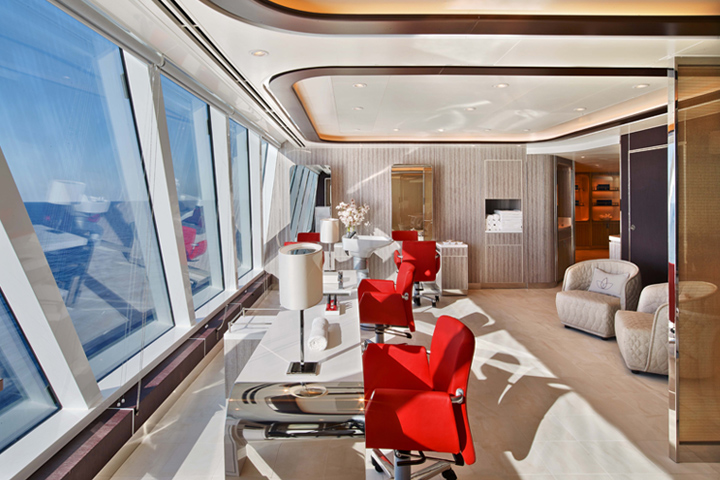
Beauty Salon
- Beauty Salon
- Full-Service Spa
- Spa Services/Massage
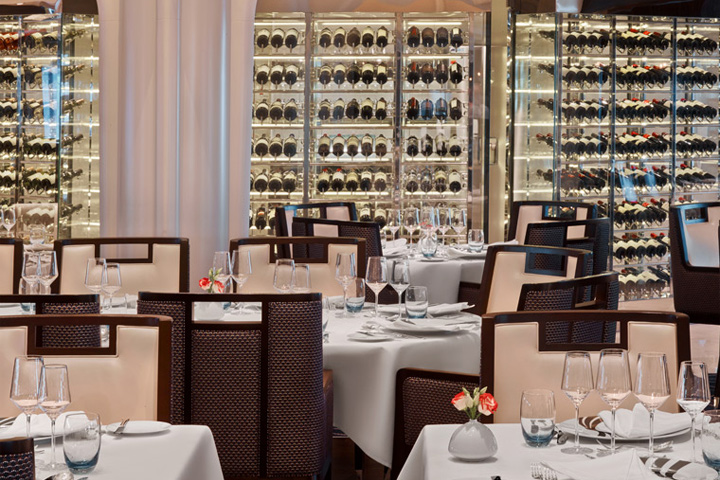
The Restaurant
Main Dining
The Restaurant: Come when you like, with whom you please, and be seated as you wish. The room is beautiful, the cuisine is exquisite, and the service is simultaneously flawless, friendly and fun.
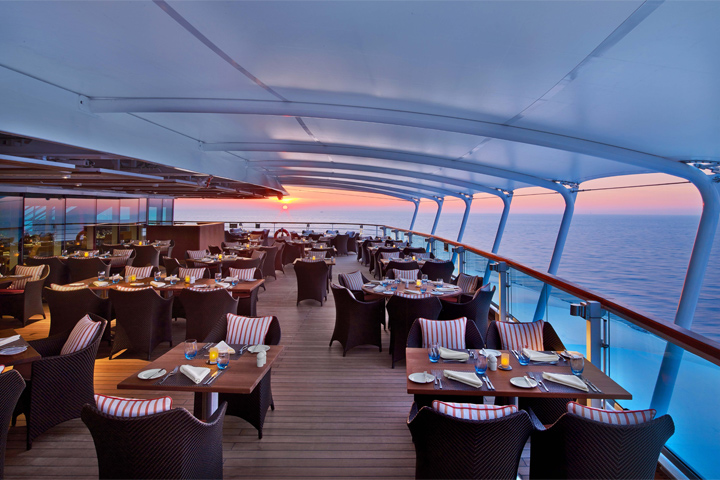
The Colonnade
Casual Dining
Coffee Bar: Enjoy a specialty crafted espresso just the way you like it.
Earth & Ocean: Each evening, the skilled chefs create an imaginative array of fresh, inventive dishes—a sophisticated menu celebrating eclectic traditional flavors from around the world, served in a relaxed setting under the stars for a distinctive dining experience unlike any other on board.
Observation Bar: A stunning round lounge with a square bar and panoramic views. Early Risers’ Coffee and Tea is served here every morning, and piano music makes it a great choice for drinks and conversation before and after dinner.
Seabourn Square: Whether you're looking for a place to enjoy your newspaper in the morning or want to socialize with your fellow passengers, Seabourn Square is what you're looking for. This inviting lounge offers plush seating, cocktail tables, a library, computer terminals, a coffee bar, and Guest Services staff.
Solis: Offering light, modern Mediterranean cuisine bursting with color and character, prepared fresh and entirely from scratch.
The Club: Open for afternoon tea then transforms into a dance club in the evening. Socialize while enjoying cocktails, live music, and great company.
The Colonnade: The more casual, indoor/outdoor alternative features an open kitchen, lavish buffets or table service for breakfasts and lunch, and serves regionally themed, bistro-style dinners with table service nightly.
The Patio: Relaxed poolside dining offering luncheon buffets, salads, soups, grilled specialties and freshly baked pizza. Dinners feature a full menu in an alfresco setting.
Sky Bar: A place to enjoy a refreshing tropical beverage during the day, or an evening cocktail under the stars.
Sushi: Seabourn researched ingredients and developed a menu that is an ideal blend of authenticity to maintain the root of the cuisine and a twist of Seabourn’s culinary expertise. The sushi concept is a modern line that is steeped in tradition and uses some of the finest ingredients. Hamachi, tuna, shrimp and other fresh fish products will be shipped from Japan to Sushi and served à la carte for dinner. The menu features caviar and small plates, along with a selection of maki rolls, sushi and sashimi, and salads.
In-Suite Dining: A varied menu available around the clock for service in your suite. You may also order dinner from The Restaurant menu and have your meal served, course by course, in your suite or on your veranda.
All Veranda Suites feature a full-length window and glass door to private veranda, comfortable living area, queen-size bed or two twin beds, dining table for two, walk-in closet, interactive flat-screen television with music and movies, fully stocked bar and refrigerator, makeup vanity, spacious bathroom with separate tub and shower.
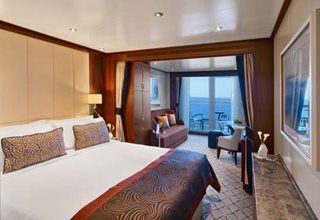
Category: V4
All Veranda Suites feature a full-length window and glass door to private veranda, comfortable living area, queen-size bed or two twin beds, dining table for two, walk-in closet, interactive flat-screen television with music and movies, fully stocked bar and refrigerator, makeup vanity, spacious bathroom with separate tub and shower.

Category: V3
All Veranda Suites feature a full-length window and glass door to private veranda, comfortable living area, queen-size bed or two twin beds, dining table for two, walk-in closet, interactive flat-screen television with music and movies, fully stocked bar and refrigerator, makeup vanity, spacious bathroom with separate tub and shower.

Category: V2
All Veranda Suites feature a full-length window and glass door to private veranda, comfortable living area, queen-size bed or two twin beds, dining table for two, walk-in closet, interactive flat-screen television with music and movies, fully stocked bar and refrigerator, makeup vanity, spacious bathroom with separate tub and shower.

Category: V1
All Veranda Suites feature a full-length window and glass door to private veranda, comfortable living area, queen-size bed or two twin beds, dining table for two, walk-in closet, interactive flat-screen television with music and movies, fully stocked bar and refrigerator, makeup vanity, spacious bathroom with separate tub and shower.

Category: SV
This category can be booked for a special rate, guaranteed to you. Please note that the category is not associated at the time of booking with a specific stateroom, deck, bedding configuration or other particular settings. The assignment of an actual cabin will be performed during your check-in. The cabin can be anywhere on the ship.

Category: RB
This category can be booked for a special rate, guaranteed to you. Please note that the category is not associated at the time of booking with a specific stateroom, deck, bedding configuration or other particular settings. The assignment of an actual cabin will be performed during your check-in. The cabin can be anywhere on the ship.

Category: OB
This category can be booked for a special rate, guaranteed to you. Please note that the category is not associated at the time of booking with a specific stateroom, deck, bedding configuration or other particular settings. The assignment of an actual cabin will be performed during your check-in. The cabin can be anywhere on the ship.
All Penthouse Suites on board feature a comfortable living area, glass door to private veranda, queen-size bed or two twin beds; walk-in closet with personal safe, two flat-screen TV with music and movies, fully stocked bar and refrigerator, writing desk with personalized stationary, makeup vanity, spacious bathroom with separate tub and shower, plush robes, slippers hair dryer and 110/220V AC outlets.
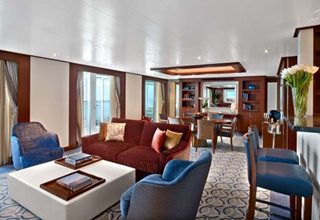
Category: GR
Suites on board feature a comfortable living area, private veranda, queen-size-bed or two twin beds; walk-in closet with personal safe, interactive flat-screen TV with music and movies, fully stocked bar and refrigerator, writing desk with personalized stationary, makeup vanity, spacious bathroom with separate tub and shower, plush robes, slippers, hair dryer, and 110/220V AC outlets.

Category: WG
Suites on board feature a comfortable living area, private veranda, queen-size-bed or two twin beds; walk-in closet with personal safe, interactive flat-screen TV with music and movies, fully stocked bar and refrigerator, writing desk with personalized stationary, makeup vanity, spacious bathroom with separate tub and shower, plush robes, slippers, hair dryer, and 110/220V AC outlets.
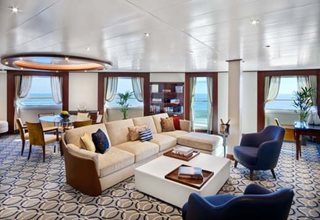
Category: SS
Suites on board feature a comfortable living area, private veranda, queen-size-bed or two twin beds; walk-in closet with personal safe, interactive flat-screen TV with music and movies, fully stocked bar and refrigerator, writing desk with personalized stationary, makeup vanity, spacious bathroom with separate tub and shower, plush robes, slippers, hair dryer, and 110/220V AC outlets.
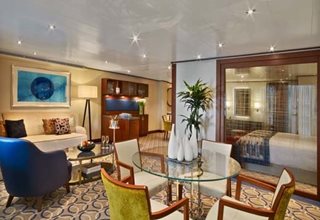
Category: O2
Suites on board feature a comfortable living area, private veranda, queen-size-bed or two twin beds; walk-in closet with personal safe, interactive flat-screen TV with music and movies, fully stocked bar and refrigerator, writing desk with personalized stationary, makeup vanity, spacious bathroom with separate tub and shower, plush robes, slippers, hair dryer, and 110/220V AC outlets.

Category: O1
Suites on board feature a comfortable living area, private veranda, queen-size-bed or two twin beds; walk-in closet with personal safe, interactive flat-screen TV with music and movies, fully stocked bar and refrigerator, writing desk with personalized stationary, makeup vanity, spacious bathroom with separate tub and shower, plush robes, slippers, hair dryer, and 110/220V AC outlets.
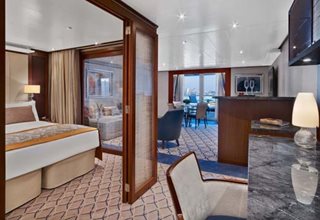
Category: PS
All Penthouse Suites on board feature a comfortable living area, glass door to private veranda, queen-size-bed or two twin beds; walk-in closet with personal safe, two flat-screen TV with music and movies, fully stocked bar and refrigerator, writing desk with personalized stationary, makeup vanity, spacious bathroom with separate tub and shower, plush robes, slippers, hair dryer, and 110/220V AC outlets.
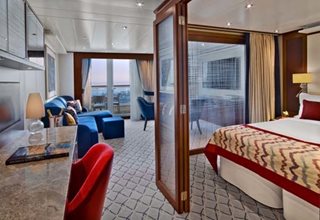
Category: PH
All Penthouse Suites on board feature a comfortable living area, glass door to private veranda, queen-size-bed or two twin beds; walk-in closet with personal safe, two flat-screen TV with music and movies, fully stocked bar and refrigerator, writing desk with personalized stationary, makeup vanity, spacious bathroom with separate tub and shower, plush robes, slippers, hair dryer, and 110/220V AC outlets.

Category: PG
This category can be booked for a special rate, guaranteed to you. Please note that the category is not associated at the time of booking with a specific stateroom, deck, bedding configuration or other particular settings. The assignment of an actual cabin will be performed during your check-in. The cabin can be anywhere on the ship.
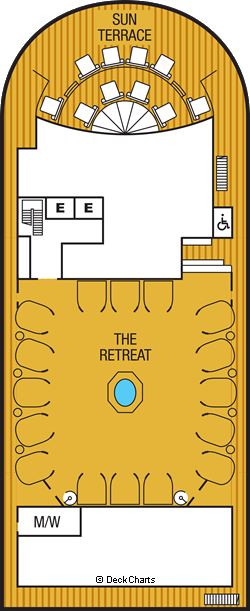
| Symbol | Description |
|---|---|
 | Subject to noise when anchoring; has all-metal veranda railings, limiting the view |
 | Wheelchair accessible suite, roll-in shower only, wheelchair-accessible doorways |
 | Elevator |
 | The veranda railings on Deck 5 are part metal and part glass from floor to teak rail; suites on Deck 5 have slightly larger verandas |
 | Third guest capacity suite |
 | Shower only |
 | Obstructed port side view with larger veranda overlooking the center pool |
 | Veranda railings are part metal and part glass; the forward half of the railing is metal and aft half is glass with teak rail |
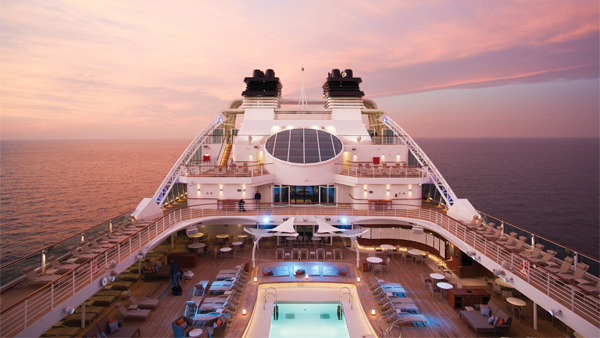
- Ship Name: Seabourn Encore
- Year Built: 2016
- Year Entered Present Fleet: 2016
- Ship Class: E
- Maximum Capacity: 600
- Number of Passenger Decks: 10
- Number of Crew: 395
- Officers' Nationality: International
- Ocean-View with Balcony: 262
- Tonnage (GRT): 43,000
- Capacity Based on Double Occupancy: 600
- Country of Registry: The Bahamas
- Total Staterooms: 300
- Suites with Balcony: 38
- Crew/Hotel Staff Nationality: International
Available Dates & Prices
Terms & Conditions
*Price shown is per person based on double occupancy, is valid for select stateroom categories only, and does include government taxes/fees and gratuities. Click on the Terms & Conditions link below for details.
**Select complimentary shore excursions are for full-fare guests only, capacity controlled and subject to availability. Shore excursion reservations are accepted on a first-come, first-served basis. Please note, available excursions vary by sailing date and day of the week. Government fees and taxes are included. Requested excursions may not be available at time of booking. Supplement will apply on Ventures by Seabourn®, optional shore excursions. Restrictions apply and penalties apply 36 hours prior to shore excursion start date.
†One Digital Costco Shop Card per room/stateroom, per stay. The exact amount of the Digital Costco Shop Card will be calculated during the booking process. The Digital Costco Shop Card promotion is nontransferable and may not be combined with any other promotion. A Digital Costco Shop Card will arrive by email approximately 10 days after the start of your cruise. Click on the Terms & Conditions link below for additional information.
Ship's registry: The Bahamas
Digital Costco Shop Card
This booking includes a Digital Costco Shop Card which will arrive by email one to two weeks after you return from your vacation. The Digital Costco Shop Card is a convenient payment option in our warehouses and on Costco.com.

